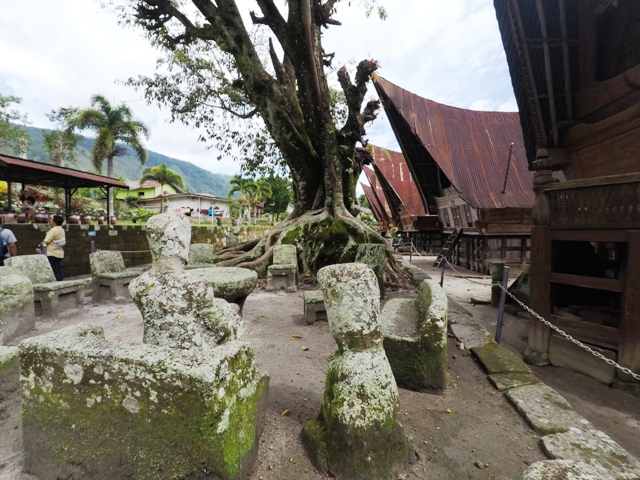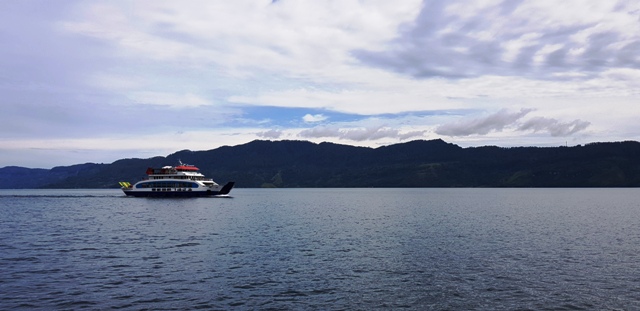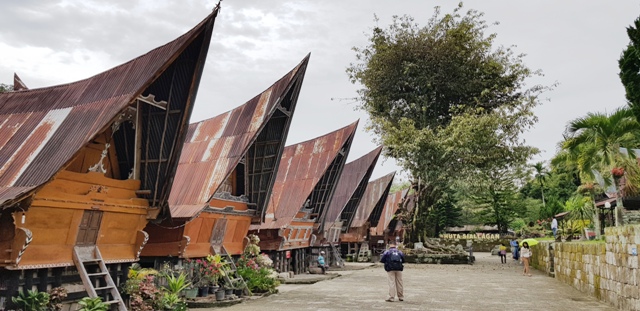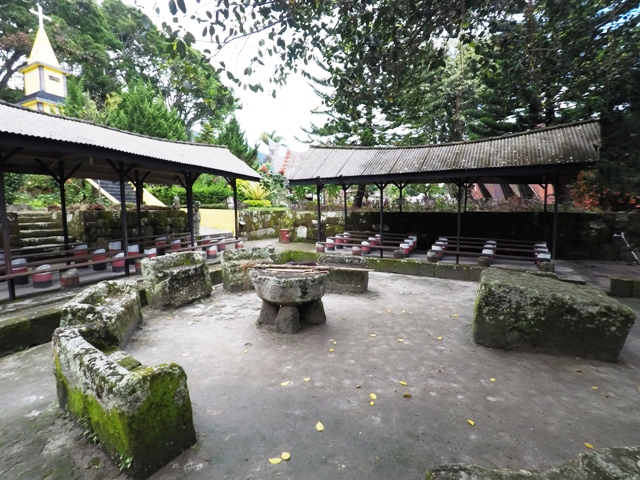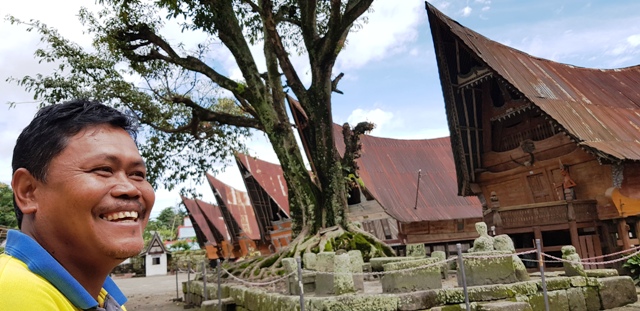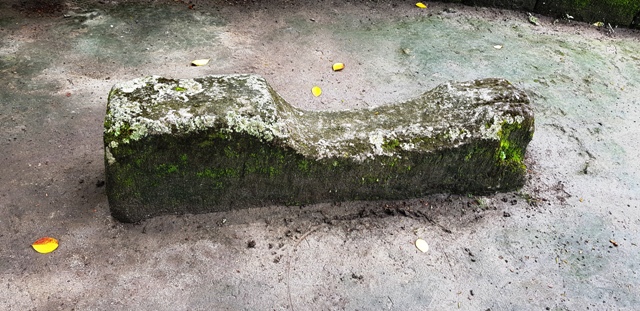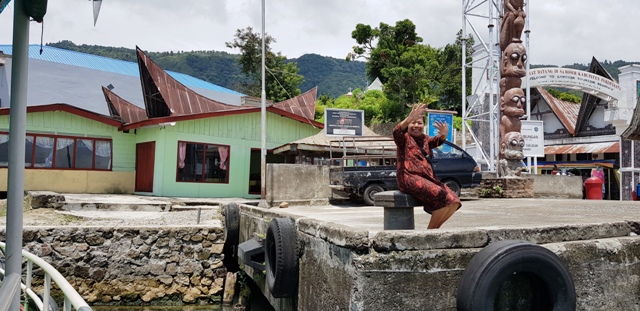If you are a fence-sitter when it comes to the supernatural – and its different ways of coming alive – Indonesia is a not-so-gentle nudge into adherence. The folklores and urban legends abound with spirits infamous for a lack of benevolence – some shriek forcing you to veer off the highway in the middle of the night while others beckon you sultrily into the deep sea. Every kris has its own unseen resident if the locals are to be believed. Some collectors I know vouch for it. ‘Just let them be,’ is how they handle it. Then it’s not like there are many options.
Whether you are primed in these tales or not, walking into Hatu (meaning ‘settlement’) Siallagan in Samosir Island from the pier, the calm does strike you as a bit otherworldly. That you cross the Lake Toba, the world’s largest crater lake (nearly the size of Singapore) to reach here gives the place an extra edge. The spirited serenading of tourists by Mama Myrna singing old Hindi songs don’t do much to shake things up. A jovial spirit, whose face lights up each time there is a request for a selfie, Mama Myrna runs a souvenir shop in this cultural showpiece.
Siallagan, which forms a part of the heritage-rich Ambarita village, has preserved in all its glory the traditions and culture of the ethnic Batak tribe of Indonesia. The people who live here are believed to be the direct descendants of the King of Batak. The ‘huta’ itself was built during the reign of the first king, Laga Siallagan, and expanded by his heirs. The remains today cover an area of 2,400 square metres and is surrounded by a stone wall which goes up to a couple of metres in some places and topped with bamboo spears for protection from wild animals and thieving, marauding enemies. Wars were mostly between neighbouring villages. A large number of the residents here are direct descendents of the first Siallagan king and the tombs of their ancestors can be found strewn around the village – epitaphs shining and grounds deracinated. Ancestors are not just a matter of pride in Indonesia but fervently prayed to for blessings to miracles.
What strikes you at first upon entering the village are the pointed, tall rubiginous roofs of the houses in a straight array. These are well-preserved residences of the Batak tradition. Though most today are used for display and demonstration of life in a bygone era, a few are still used as SOHOs. Bagus (meaning ‘good’), who owns a shop in one, a Siallagan by virtue of marriage, is also an occasional tour guide.
“The Batak houses do not use nails in the construction,” he said. “Instead the wood is tied with rattan which makes them earthquake resistant.”
The Lake Toba surrounding the island of Samosir was a caldera, or the crater formed by the eruption of a super volcano 74,000 years ago. It was the most explosive eruption known to happen on earth the past 25 million years and is believed to have wiped out most of the humans alive.
“Siallagan,” Bagus continued, “is thus located within a ‘ring of fire’ where volcanic activity continues.” Surely, the region was prone to seismic movements and the architecture style made it withstand earthquakes.
Batak houses were of two kinds – bolon and sopo. While the bolon was a proper structure with walls, used for residential purposes, like the one Bagus showed me, the sopo was an open structure with no walls. It was generally used as a storage for harvest or as hoks. A wooden stairway led up to the living quarters with bunk beds, a cooking area with grindstone and boxes and other containers made of rattan. Bunches of freshly harvested maize were hung from the low rafters to give an idea of how life was. A rusted metallic box sat on a ledge, dusty and foreboding. It had three latches of which two were broken and one held it fast. Seeing me eye it curiously Bagus frowned. Shut and locked containers could be holding anything in Indonesia.
The biggest draw of Siallagan is however the ‘Batu Parsidangan’ which is two sets of large stones carved into chairs around a stone table. It means ‘stones for meetings and trials’ and is located in the village square beneath a patulous Hariara tree considered sacred by the locals. The stone chairs and tables are believed to be over 200 years old. The first set is an orderly arrangement of chairs specifically intended for the king, queen, clan elders, important invitees and the datu or spiritual leader. The second is the same set of arrangement but around a stone table. Next to the table was a longish slab – each with their own distinct purpose.
Once a prisoner was sentenced to death, the datu would consult the calendar for a suitable date to carry out the execution. There were replicas of every ancillary used – from the ancient scroll calendar to the dagger and the ceremonial sword. On the appointed day, the prisoner would be placed on the big slab at the centre of second stone set and the datu would stab the condemned multiple times to release any black magic powers he might possess. Afterward, the executioner would carry out his responsibility on the horizontal stone slab with a distinct groove. The Siallagan execution didn’t end here. The datu would step in again and tear out the heart of the headless prisoner and hand it to the king. Proof of death, perhaps.
The execution area is, understandably, where the tourists get additionally curious and the locals loquacious. There was an incident a few years ago where a Spaniard began talking in Batak language, capering around the beheading stone. Several Christian missionaries are believed to have lost their heads here. The one missionary who escaped was the German Ludwig Ingwer Nommensen who translated the first Batak Bible from German. He not only got to keep his head but was allowed to flourish as well. There are a few timber churches still standing in the region believed to be his legacy. Just when you are looking around with, neck hair in attention, Mama Myrna takes your hand and begins to sing ‘Jeena yahaan, marna yahaan…’ You don’t know whether to join in or run.
A few minutes’ walking distance from Siallagan are Tomok and Tuk Tuk where the more familiar sights of tourism meet you. Hawkers try to ply you with batik shirts and ulos, sacred shawls, wayang and leather puppets and handcrafted gambus and model gamelans. Sprightly tykes beseech you to throw coins into the Toba which will be retrieved by them before you count to 10.
Though in the neighbourhood, a far cry from the unnerving quietude of Siallagan.


